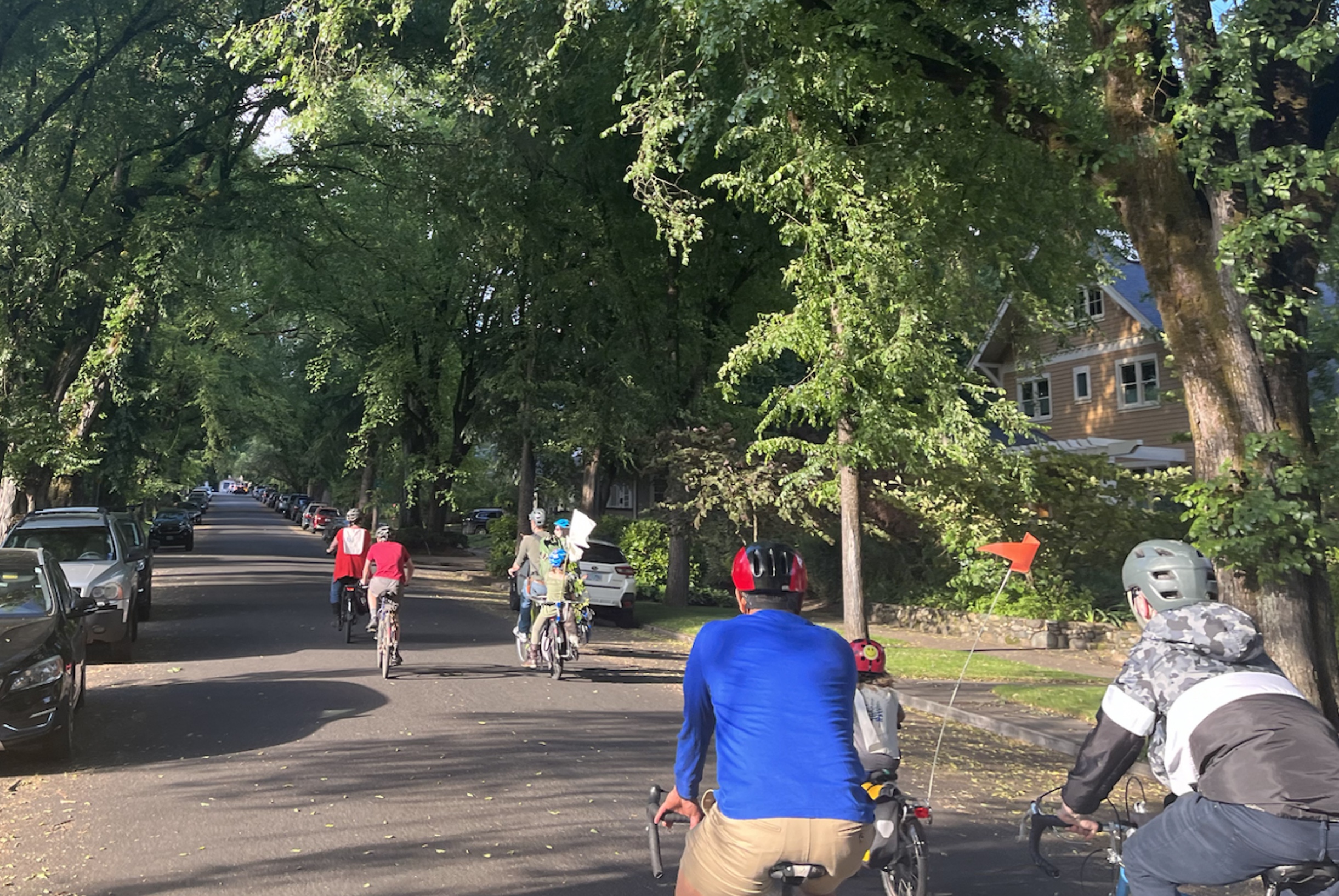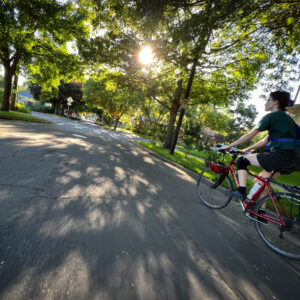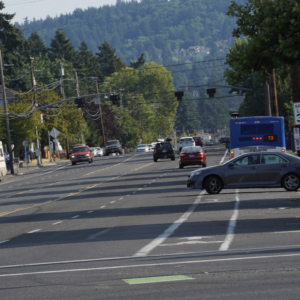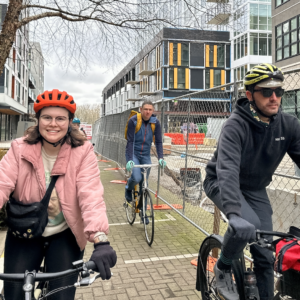The heat dome that enveloped the Pacific Northwest last June was catastrophic and traumatic for people across the region. Temperatures skyrocketed to unprecedented heights: on June 28, 2021, Portland heat reached an average of 116 degrees. This surpassed not only local records, but also shot past the historic high in Dallas, Texas. At the time, it was all anyone could talk about.
But a year has passed, and people tend to forget. In order to make sure that didn’t happen, Portland activists and scientists organized Heat Week to commemorate the anniversary. Throughout this week, they’ve hosted events to remind people what it was like to experience such a remarkable event and recognize the people who were most impacted by the heat, including the people who died because of it.
Last night, I attended one of these events: the Heat Week Climate Resiliency Ride. Activists from environmental justice group 350PDX wanted participants to learn about “shade equity” and how tree canopy coverage — or lack thereof — impacts people in different parts of the city. They led a group of about two dozen people from the lower-income Lents neighborhood near the edge of southeast Portland to Colonel Summers Park in the wealthier, whiter Buckman neighborhood in inner southeast, and the difference in greenery was stark to see.
“One of the things we’re going to be doing in the ride is visually and sensorially taking in the shade,” Brenna Bell, one of the ride organizers and 350PDX’s Forest Climate Manager, said to the group at the beginning of the journey. “We want to help people not just hear about [tree canopy coverage], but also see it and feel it.”
“Feeling it” wasn’t as easy yesterday, because the weather was lovely in and out of shade. Organizers (somewhat) jokingly expressed disappointment about how nice it was – a breezy 75 degrees with some clouds. Fortunately it was nearly 100 just one day before, so it was easy to use our imaginations.
After we left the nicely forested Lents Park and headed on the route, we didn’t see much shade for quite some time. We made our first stop in a parking lot on the corner of Southeast Woodstock and 92nd. Portland State University professor Dr. Vivek Shandas, who researches climate change adaptation and urban heat islands, came out to measure the temperature in this parking lot last year. He found that thanks to an unbalanced ratio of pavement to trees, this spot was the hottest place in Portland during the heat dome, with temperatures reaching an astonishing 124 degrees.
We gathered in this parking lot to have a moment of silence for the 69 people in Multnomah County perished from the heat last year.
“If we don’t bring attention to the fact that so many people died last year, it’s going to be a forgotten topic. And it’s going to be something we just don’t really make much progress on,” Shandas said.
Shandas passed out thermometers so people could see the temperature difference under varying levels of shade and get a taste of the data collection process.
“You can think about what it means to be doing science in a moment of massive transformation on a planetary level,” Shandas said. “This is a way of taking those big global climate models and bringing them down to our backyards.”
One of the most dangerous parts of the heat dome last year was that the temperatures just wouldn’t let up. Usually night time offers a respite, but in Portland’s urban heat deserts, temperatures remained high all evening. In Lents, it remained 91 degrees at night. In places with more shade, evening temperatures dropped to the 60s and 70s.
At the planet warms, urban forestry is becoming a key intersectional issue with transportation infrastructure. Community feedback for the Portland Bureau of Transportation’s 122nd Avenue Plan indicated a strong demand for trees in new streetscape projects – and as more extreme heat events happen due to the climate crisis, the need for trees will become even more evident. Many concerned Portlanders have noticed that TriMet’s soon-to-open Division Transit Project came with large center median islands that are completely devoid of trees.




As we made our way northwest, crossing 82nd Avenue and moving through the Foster-Powell, South Tabor, Richmond, Hosford-Abernethy and Buckman neighborhoods, we saw less concrete and more trees. I could sense the group relax as we headed west onto more tree-lined and bike-friendly streets.
Bringing the benefits of trees to more streets will be essential to reach many of Portland’s planning goals, but some advocates say the City of Portland is falling short on this front. Earlier this year, Portland ended its relationship with non-profit tree-planting group Friends of Trees. The city says it will continue planting trees on its own, but they’ll have their work cut out for them as the canopy is already shrinking due to inclement weather, tree diseases caused by pests, and urban deforestation.
It shouldn’t be difficult to plant more trees. It’s relatively uncontroversial that they’re nice to have around. Trees are a big part of Oregon pride – the big evergreens and Oregon maples are what makes our landscape here so unique and enticing. It’s a luxury more people should benefit from.
“You walk around Portland and it’s literally like being in the forest. It’s is such an amazing place to live, but we have to build it out, and we have to build it together,” Bell said. “Shade equity is part of building a city that works for everyone, and everyone deserves shade.”










Thanks for reading.
BikePortland has served this community with independent community journalism since 2005. We rely on subscriptions from readers like you to survive. Your financial support is vital in keeping this valuable resource alive and well.
Please subscribe today to strengthen and expand our work.
Green leaves are certainly better than nothing but if we genuinely want to create more heat-resilient cities, highly-reflective roofs, building walls, and surfaces (e.g. low-carbon reflective concrete) are essential. There is a reason that so many cities in very hot places are blindingly white.
https://www.tandfonline.com/doi/abs/10.1080/2093761X.2016.1167644
https://journals.sagepub.com/doi/10.1177/0144598717716285
(We should also de-pave most of our roadways because how many @#$%ing roads do you really need in a resilient city?)
Note: It’s possible that polymers that are blindingly white could be used as white pigments without the CO2e intensity of mining titanium or barium. https://www.nature.com/articles/s42004-019-0202-8
Except we don’t live in a very hot place. We live in a place where significantly more energy is spent heating spaces than cooling them. Why would I make my house more reflective, when 90+% of my energy expenditures go towards heating my home 7 months of the year?
The absolute best energy efficiency feature of my particular house is the 100+ year oak tree that shades it in the summer, and allows solar energy through in the winter. It’s the best of both.
And your oak tree is, at worst, CO2 neutral. Too bad we don’t require those to be included with new construction.
We live in a place where over a hundred people died from a heat wave. Perhaps we should prepare for our unavoidable very hot future (e.g. resilience).
Weather does not equal climate. How will a 3-5*F average temperature increase over the next 50 years affect our needs to heat in the winter and cool in the summer? 50 years from now, we will still spend more energy heating our spaces than we do cooling them. And residents will continue to die of cold exposure every winter (more than from excess heat).
https://cliffmass.blogspot.com/2021/09/heat-wave-versus-cold-wave-deaths-in-us.html
https://cliffmass.blogspot.com/2021/07/flawed-heatwave-report-leads-to-false.html
I was going to ignore your belief that the absence of leaves on a tree in the winter substantially decreases your heating costs but since I gotta respond to the above please chew on this graph of solar irradiance (surface level PNW):
Adapted from: https://journals.ametsoc.org/view/journals/hydr/17/1/jhm-d-15-0087_1.xml
A simple figure from the IPCC that illustrates how global heating influences the probability of temperature extremes:
(Fig from IPCC AR4)
The growing power and geographic refinement of climate modeling has led to advances in attribution science:
Preprint: https://www.worldweatherattribution.org/wp-content/uploads/NW-US-extreme-heat-2021-scientific-report-WWA.pdf
Final publication:
https://esd.copernicus.org/preprints/esd-2021-90/
A discredited meteorologist’s blog post vs peer-reviewed published science by actual climate scientists.
https://www.seattletimes.com/seattle-news/seattle-meteorologist-cliff-mass-sparks-controversy-by-diving-into-heat-wave-climate-science.
Why do I even bother posting here?
We have long been supporters and volunteered with Friends of Trees. But it is demoralizing to spend our time and money planting little saplings when the City won’t protect mature trees along our rights-of-way.
I urge everyone who bikes the MUPs to be on the lookout and report the invasive vine Clematis Vitalba that is smothering our trees to death and spreading its seeds.
I started noticing the vines in the fall/winter when they are covered with dandelion-fuzz-like seedheads blowing all over. This time of year they are leafed out and growing very rapidly, blanketing trees. (You can see examples in some spots along the Springwater Corridor between SE Ivon and Ochoco.)
Please report to Urban Forestry and Bureau of Environmental Services. Follow-up with them and insist that they mitigate the locations you report. Urge them to add smothering vines to the tree code.
If a property owner or government entity allowed or caused a tree to die by injuring its roots, bark, trunk, branches or foliage, or by poisoning, insect infestation, disease, girdling, failing to maintain (water, etc.), topping or excessive pruning, or cutting down without a permit, it would be in violation of Portland tree code.
Yet trees are allowed (or caused) to die by these devastating vines, and Urban Forestry won’t do anything until after the tree is dead and poses a risk by falling.
https://www.portlandoregon.gov/parks/47247
https://www.portland.gov/bes/invasive-plants/report-invasive-plant
Steve Lower at 503-823-1640 (Parks and Rec/Urban Forestry steve.lower@portlandoregon.gov)
mitch.bixby@portlandoregon.gov 503-823-2989 (Bureau of Environmental Services)
Old Man’s Beard (Clematis vitalba)
A cousin to our garden clematis varieties, but this one is not well behaved. An invasive climber, this plant can grow 30 feet in a season, and is able to smother large trees. Its fluffy seeds spread far and wide.
None of the big street trees I know about (outside Ladds and Laurelhurst) will be replaced when they die — the city now favors (requires) much smaller varieties. Furthermore, we encourage developers remove large trees on private property and replace them with small street trees or just pay into a fund.
The formula is simple. Want more shade? Incentivize (and enable) planting big trees!
Great article about an important subject. Thanks again, BikePortland
I asked a few folks from BES about why we weren’t, for instance, planting trees in the parking zones in most streets. They said a lot of it has to do with what utilities and drainage systems are underground.
Or to put it another way, the city isn’t willing to prioritize tree canopy in the parking lane by rerouting water lines, sewer lines, and other utilities that aren’t on power poles. And somehow they’ve forgotten how they routed gas, water and sewer lines back in the good old days before streets were paved, under sidewalks in many cases.
Many cities route such utilities through alleyways and onto utility easements behind properties which is easy enough in East Portland and SW.
Since inner Portland blocks are so small, the city could make every other street a utility/pedestrian easement and close off the street to all through car traffic (local deliveries only), then plant trees on the open streets and gradually convert the inner city to tree-lined medians on traffic streets and tree-lined woonerfs/living streets on the others.
I think it’s more like the city doesn’t have the money to do that. Moving utilities isn’t cheap.
Tree-lined medians not only provide shade and reduce urban heat island effects, they are also a well-known traffic calming tool, and Portland needs a lot of traffic calming.
Why don’t more busy streets throughout Portland have tree-lined medians?
Why not plant trees down the center of Broadway downtown and in NE Portland? Why are there trees along the center of Burnside for 3 blocks downtown but not along the other parts of the street? Why do Portland’s urban interstates have no trees? I’ve seen them in other major cities. Wouldn’t Sandy be ideal with trees? SW 4th & 5th? SE Morrison?
And why are you singling out Division? Outer Division is not going to ever have trees planted down the middle nor light rail there because of its Bull Run aqueduct. However, the city could remove the parking lane, move the bike lane to the curb, and plant trees in the street.
Example from Carlisle UK: https://www.google.com/maps/@54.8936965,-2.928284,3a,75y,253.02h,90t/data=!3m7!1e1!3m5!1sbaqFqA8F2DZuRmkYM33XJA!2e0!6shttps:%2F%2Fstreetviewpixels-pa.googleapis.com%2Fv1%2Fthumbnail%3Fpanoid%3DbaqFqA8F2DZuRmkYM33XJA%26cb_client%3Dmaps_sv.tactile.gps%26w%3D203%26h%3D100%26yaw%3D242.03922%26pitch%3D0%26thumbfov%3D100!7i16384!8i8192
It was measured at 123 degrees last summer in the air just east of SW Arctic Drive in Beaverton, OR.
ODOT ant city of Portland Parks are guilty of tree abuse along the magnificent corridor of mature oaks at Westmoreland Park and Macadam. Parks uses the tree’s root zone as a maintenance road. This compacts soil, eliminates necessary pore space and physically damages the roots. At least one tree is dying. I have contacted Parks and the Urban Forester – crickets
Homeowners can do a lot to green up our city just by planting as many trees as they can fit on their lot. It influences neighbors to plant more trees. Trees beautify the place and the message gets through.